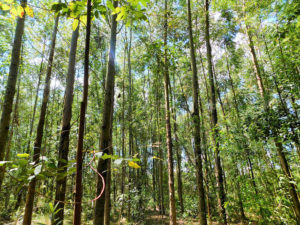Pressure to manage the world’s resources responsibly for people, biodiversity and the climate has perhaps never been so intense. In this context, the landscape approach, which has grown in popularity in land management circles in recent years, may hold critical importance.
So what is it all about? According to a definitive research paper, the approach seeks to provide “tools and concepts for allocating and managing land to achieve social, economic, and environmental objectives in areas where agriculture, mining, and other productive land uses compete with environmental and biodiversity goals.”
Watch: Developing and applying an approach for the sustainable management of landscapes
It asks us to take a step back and look at land management holistically, through the lenses of a range of disciplines, and with an eye to the bigger picture and the longer term. “Landscapes can’t be managed as a project,” explains Terry Sunderland, Senior Associate at the Center for International Forest Research (CIFOR) and professor at the University of British Columbia. “They can only be really managed as a process.”
CIFOR scientist James Reed emphasizes the importance of multiple scales when analyzing landscapes from this perspective: “Whatever the unit of analysis is, we’re trying to consider what’s happening at the scale below and the scale above as well. So that includes global commitments, and how they filter down to national and landscape-level implementation.”
SOMETHING OLD, SOMETHING NEW
Is this approach new? Yes and no, says Sunderland. Certainly, it represents a marked shift from project-based approaches and rigid disciplinary boundaries that have pervaded the sector in the past. But in other corners of the world, the guiding principles may well be anything but novel.
“Currently there are two billion people living and working in very complex landscape mosaics,” says Sunderland. “Most of these people are farmers. Seventy percent of the world’s food is generated from such landscapes.”
So while some might see the landscape approach as just another Western paradigm being imposed on the world’s farmers, the reality might be the reverse.
“People who live and work in these complex landscapes already live and work in a holistic manner,” says Sunderland. “They understand the complexities of the different land uses within their landscapes. And I think that’s what needs to be harnessed, the bottom-up approach.”
Policy frameworks are important, he acknowledges, so that ground-level holistic management can be integrated with activities at higher scales. “But I think the real impetus is going to be coming from those two billion people living and working in these complex landscapes,” he says. “So we have to focus on how we can harness that energy and that perspective.”
Reed highlights the importance of participatory, collaborative processes to bring about these ends: bringing stakeholders together to discuss their needs and aspirations for particular landscapes, and trying to build consensus about their management.
“The idea is that through regular dialogue processes we can develop more solutions that enable people who are losing to benefit more,” he says, “and create more winners within each landscape.”

FUNDING FOR THE FUTURE
The approach aligns well with the Sustainable Development Goals (SDGs), which favor broad, integrated processes. But recent studies have shown that there’s a significant gap between the funding that’s available and that which is required to actually make these global commitments a reality – to the tune of up to seven trillion dollars.
“It’s going to require transformational changes in policy and in finance investment strategies,” says Reed. “Currently we’re way below this level of investment for producing sustainable landscapes.”
As Sunderland adds, most funding is on short-term cycles, which don’t fit well with the longer-term commitments required from a landscape approach. “So if we want to move from project to process, we have to find mechanisms in order to fund that.”
Watch: Generating science and solutions
MOVING RIGHT ALONG
Still, Sunderland is pleased about the progress of the landscape approach agenda thus far, and optimistic about its potential for the future. “It’s already starting to happen,” he says. Silos are breaking down, and overarching commitments like the SDGs take holistic approaches, acknowledging interconnection.
He cites the example of the EAT Foundation conference in Indonesia last year, which focussed on the pressing issue of feeding the world’s people a healthy and nutritious diet, while staying within safe ecological limits. “And five ministries from Indonesia were represented!” he exclaims. “All talking to each other about how to transform the food system in the Asia-Pacific region. Now that’s progress! That wouldn’t have happened two or three years ago.”
“We often hear talks about a paradigm shift, and the need for transformational change,” says Reed. “But we can’t expect it to happen overnight. Progress is happening, and it’s going to take time, but we’re moving in the right direction.
By Monica Evans, originally published by CIFOR’s Forests News.
For more information on this topic, please contact Terry Sunderland at terry.sunderland@ubc.ca or James Reed at j.reed@cgiar.org.
This research forms part of the CGIAR Research Program on Forests, Trees and Agroforestry, which is supported by CGIAR Fund Donors.
This research was supported by the US Agency for International Development (USAID) and the Department for International Development (DFID).











